Revamping Your Kitchen for a Comfortable Future: Aging-In-Place Kitchen Guide
Thanks to modern medicine, technology, and a multitude of other factors, lifespans are longer than ever around the world. Today, people can expect to live well into and beyond their sixties. According to the World Health Organization, 1 in 6 people will be aged 60 years or older by 2030.
As you age, your abilities and needs will shift as your body undergoes natural changes. Mobility, hearing, vision, and cognition are areas where people often experience new challenges.
Although most people don’t like to think about it, aging is inevitable for all of us. There is a silver lining, however: Since we know that aging will eventually occur, we can make preparations to ensure a fulfilling, healthy, and comfortable future for ourselves.
One major element to create a plan for is your living situation. As you grow older, the house where you spent most of your adult years (and may have raised your family in) may not be suitable for your current needs. If that’s the case, there are a few different paths you may choose to take, with “aging in place” being one of those options.
What is aging in place?
“Aging in place” is a term used to describe remaining in your home as you age. Many people do not want to leave the place where they made a lifetime of memories and fostered a community around them, and there are many more valid reasons why someone may not want to leave their Seattle home when they reach an advanced age.
To help people achieve their goal of aging in place, modifications can be made to different rooms around the home to accommodate various needs and create a safer, more functional environment.
One of the most important rooms to equip for aging in place is the kitchen, the most potentially dangerous room in the home. Although the kitchen can be hazardous, it is also an essential room for everyday life and maintaining independence as the conduit for nourishing oneself.
What is the goal of an “aging in place” kitchen remodel?

All considerations and suggested modifications included in this guide share one goal: to create a safer kitchen environment that makes using the space simpler, easier, and more enjoyable for people with a variety of accessibility needs.
Modifications will employ one of the follow tactics to achieve this goal:
- Reducing strain – As we age, our strength can falter and our muscles, bones, and joints will be more fragile. Reducing the amount of effort required for different tasks around the kitchen will prevent unnecessary injury.
- Removing hazards – A variety of factors can make us more accident-prone when we are older. At an advanced age, accidents will have steeper consequences: injuries can be more serious
- Improving accessibility – Aging will affect us all differently. Everyone will experience their own unique combination of mobility, visual, auditory, and cognitive impairments. These changes will be unpredictable and happen over time. To be prepared for many years to come, modifications will accommodate a wide scope of abilities.
Many of the suggested changes incorporate the principles of Universal Design into the room. “Universal Design” was coined in 1980 by Ron Mace, an architect diagnosed with polio. It is “design that’s usable by all people, to the greatest extent possible, without the need for adaptation or specialized design.”
These principles are a great start, but your kitchen should be modified to you and your needs specifically. Aging in place remodeling takes into account your distinct life patterns and preferences to create a space that truly enables you to thrive.
See also: Should I Remodel My Kitchen & Bathroom at The Same Time?
Aging in place kitchen checklist, by area
Now that we understand the overarching goals of designing a kitchen to successfully age in place, let’s break down what this should look like for each component of the room.
Floorplan
- Locate the kitchen on the first (main) level of the home. Stairs will become harder to navigate as you age. Placing the rooms that are essential for everyday living on the ground level will reduce the number of flights you need to take day-to-day.
- Maintain clearance space. Narrow spaces can cause unnecessary bumps and injuries, and a wider area is necessary for walkers and wheelchairs to move through. As a rule, doorways should measure at least 36” across, and pathways should range from 42” – 46” wide.
- Place major appliances where it’s convenient for you. Traditional design concepts promote the “work triangle” – having your stove, sink, and refrigerator laid out in a triangle that allows easy access to all these components at once. You may also consider a layout that is more custom to your needs, perhaps placing the refrigerator closer to the dining room or family room if it’s a priority to access the fridge easier from these spaces.
- Add safety equipment. Make sure there is a thermostat, fire extinguisher, and phone/medical alert device located in easy-to-reach places, to help prevent and respond to any potential emergencies.
Flooring
- Remove “speed bumps.” Uneven surfaces on the ground are potential tripping hazards and can be difficult to maneuver wheels over.
- Limit rugs. Rugs can also be tripping culprits, so it’s best to avoid using them in the space.
- Get as close the ideal material as you can: Strive for flooring with no glare (to help with visibility), texture (to reduce slipping), and a little “give” (to be gentler on your joints). Rubber, cork, and vinyl are great options to consider.
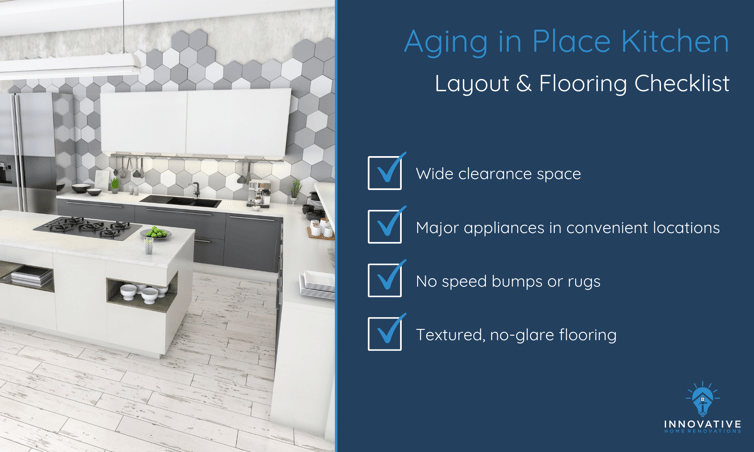
Storage (Cabinets, drawers, pantry, etc.)
- Choose drawers, not doors wherever possible. It can be difficult to reach into cabinets with deep shelves. Leveraging drawers in these spaces will allow better utilization of the space with less stretching, crouching, and straining.
- Use D shape handles. Knobs can be harder to pull and operate. Opting for handles that are easy to grab will improve your ability to open drawers, doors, and cabinets.
- Eliminate height difficulties. Add a pull-down shelf or a pull-out step to aid access to hard-to-reach areas. These shelves will bring the items closer to you, and the steps will give you an easy height boost where necessary.
- Put heavy/bulky items at counter-level or in lower areas. Lifting heavy items over your head can be a strenuous task, so rehome those items to places that are easier to access and lift from.
Pro Tip
Adding an “appliance garage” will ensure that your kitchen appliances are easily accessible, yet hidden so that the space looks tidy and attractive.
- Keep frequently used items within reach. To reduce the amount of energy you need to complete everyday tasks, strategically place your most frequently used ingredients and supplies in areas that are easiest to locate and take from.
- Make corners accessible. Storage in corners can be hard to reach, but there are ways to get more from your space with less strain on your body.
- Increase visibility with paint or lights. To view your stock and find items easier, paint the inside of cabinets white. This light color will provide contrast to the contents inside. Another option is to add lights inside your cabinets for increased visibility.
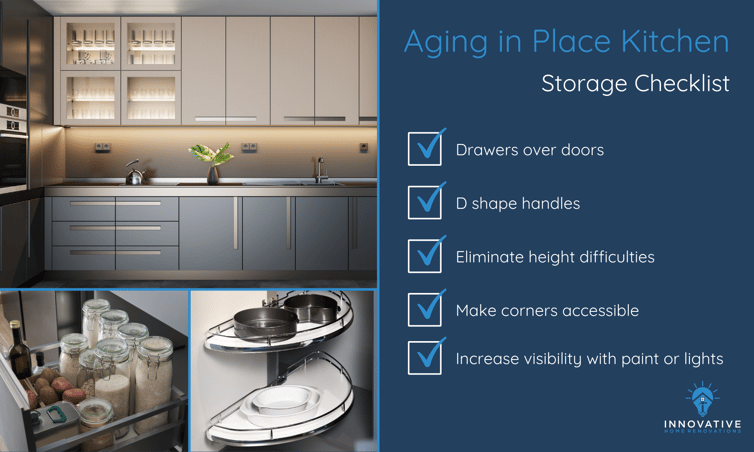
Counters
- Round them out. Sharp edges and points can cause injury; rounded edges and corners will be much more forgiving when bumped into.
- Incorporate multiple heights. Having options to work standing, seated, or in a wheelchair will help you choose the workspace that is most suitable for you every time. The standard height for a counter is 36” for those who are standing, and 28-32” to accommodate a seated position. Keep in mind there should be 30” wide and 27” high for knee space.
See also: How to Choose the Best Countertop For Your Seattle Kitchen
Appliances
- Ensure nothing juts out. To make moving about easier and prevent injuries, appliances should be counter-depth to create an even workspace.
- Choose a shallow sink. Deep sinks can be hard to reach into, a shallower sink will prevent that undue strain.
- Place microwave at or below counter height. This will help you avoid lifting plates of food or other items higher than you need to.
- Opt for a wall oven and cooktop over a traditional range. A wall oven can be placed at the location and height that is optimal for you and your ease; aligning it to a counter so that can easily transfer dishes between the two with minimal bending or lifting is ideal. A cooktop will also provide an easier transition to the counter than a traditional range. Cooktops can be placed at multiple heights and cool off quicker.
Pro Tip
Install a pull-out shelf under your wall oven to rest dishes on after taking them out of the oven.
- When choosing a refrigerator: Side-by side-refrigerator/freezers with French doors (for a low swing radius) and long handles that are easy to grab will be ideal. Inside, the fridge should have plenty of drawers to bring contents to you and ample lighting.
- Spring for safety features and smart devices. Choosing appliances with advanced safety features is a great way to prevent accidents and improve your peace of mind. Many appliances will have auto shut-off features or smart device capabilities; settings that can be controlled from a mobile device or tablet. Hands-free faucets with anti-scald devices are a great way to reduce risk as well.
See also: How to Transform Your Seattle Kitchen with Expert-Approved Appliances
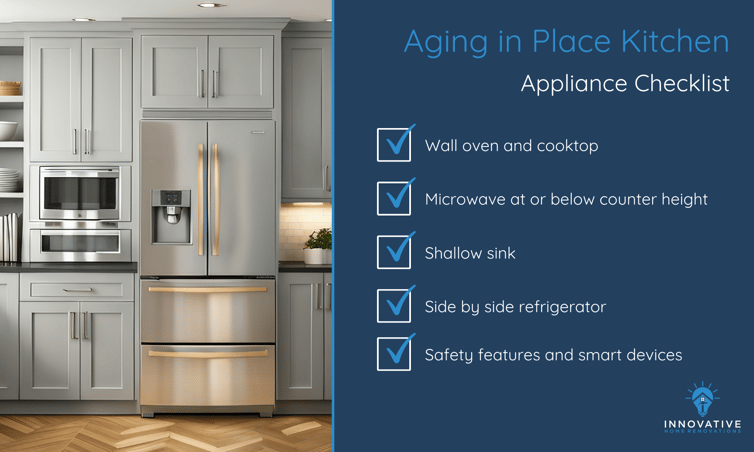
Lighting
- Uplevel the lighting. Being able to properly see your space will prevent accidents. Under-cabinet lights will help illuminate your workspace, while lighted toe-kicks will improve visibility along the ground. Placing lights inside cabinets and along open shelving will help you locate items more easily. Modern lighting now has smart capabilities as well, so you can have fine control over your space’s brightness.
- Make windows easy to operate. You should incorporate as much natural lighting as you can, with windows that are easy to adjust. Casement and awning windows are typically the easiest to open, with cranking levers that can be lengthened to your needs.
See also: 5 Key Kitchen Lighting Ideas
How to upgrade your kitchen to age in place
Although aging is unpleasant to think about, it is empowering and rewarding to prepare for your future self. If it is your goal to live in your home for as long as you can, taking action to create a space that will enable you to do so is key.
To begin, think about the needs you have at the current moment and the considerations that you anticipate will be important later on down the road. At the same time, think about your design style. Making your space more functional for the future does not mean you have to compromise on attractive design or taste.
Design your kitchen for the future with an expert
There are many factors that go into creating a safe, comfortable, and well-designed kitchen for someone that is aging in place. Working with a professional team will ensure that all important considerations will be taken into the remodel.
Ready to embrace aging in place?
Innovative Home Renovations will help you design and build a Seattle home that will suit you for years to come. Contact us today to start your journey toward a home that supports your goals for the future.


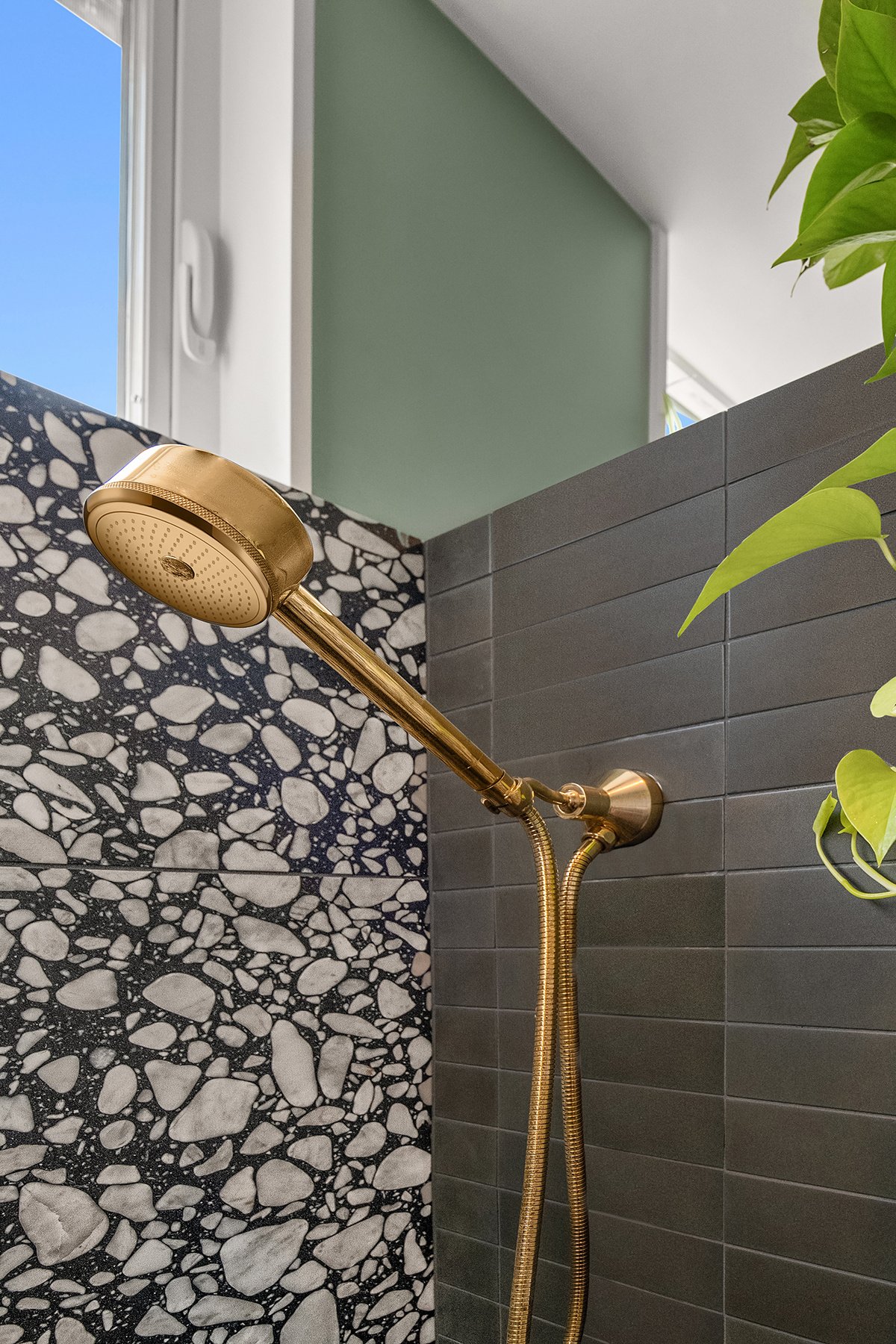
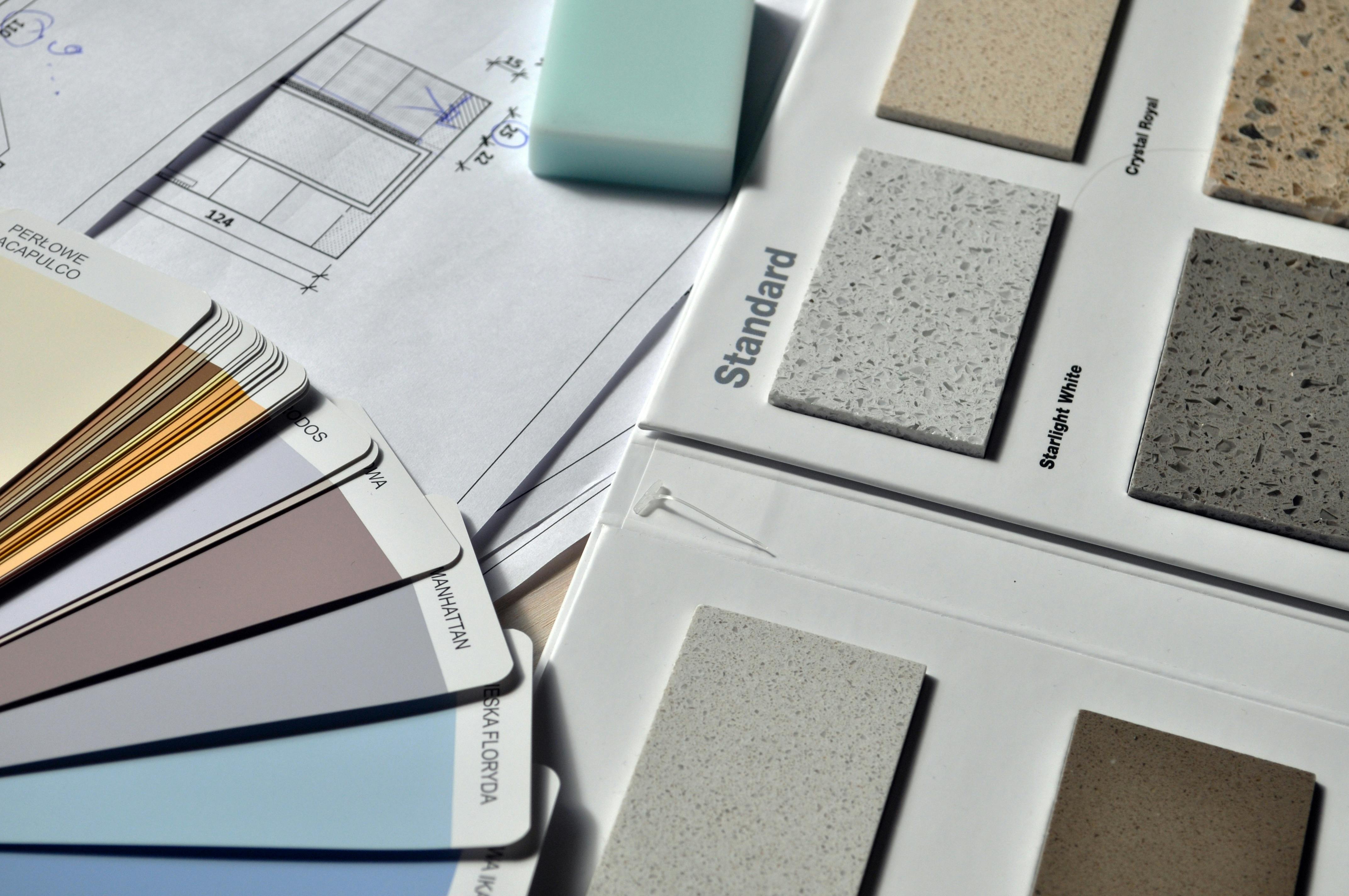

by Haley Carroll